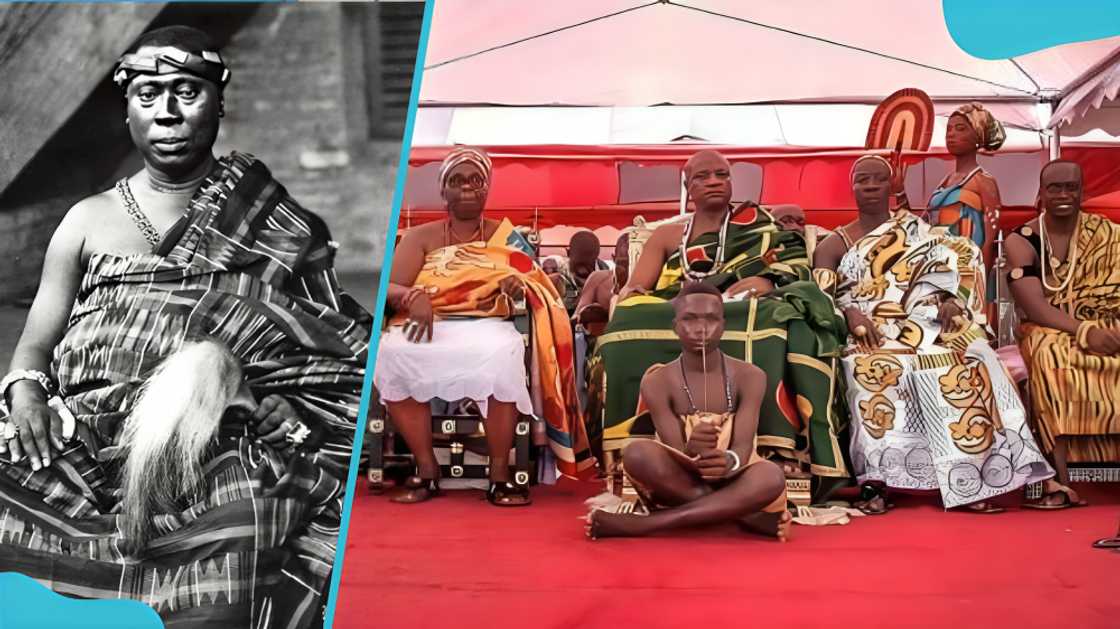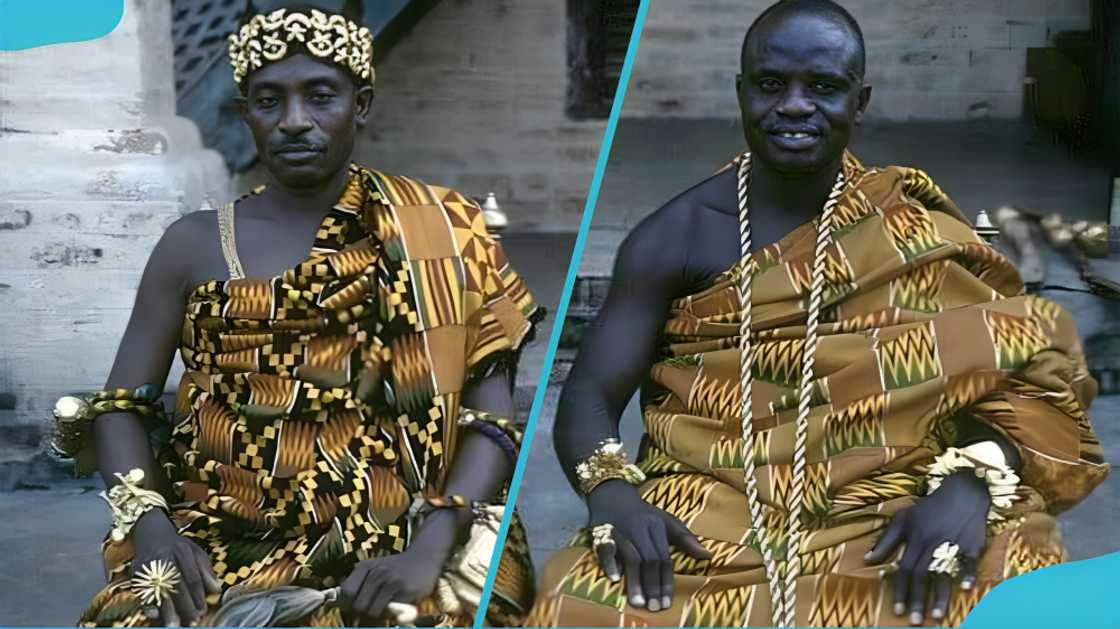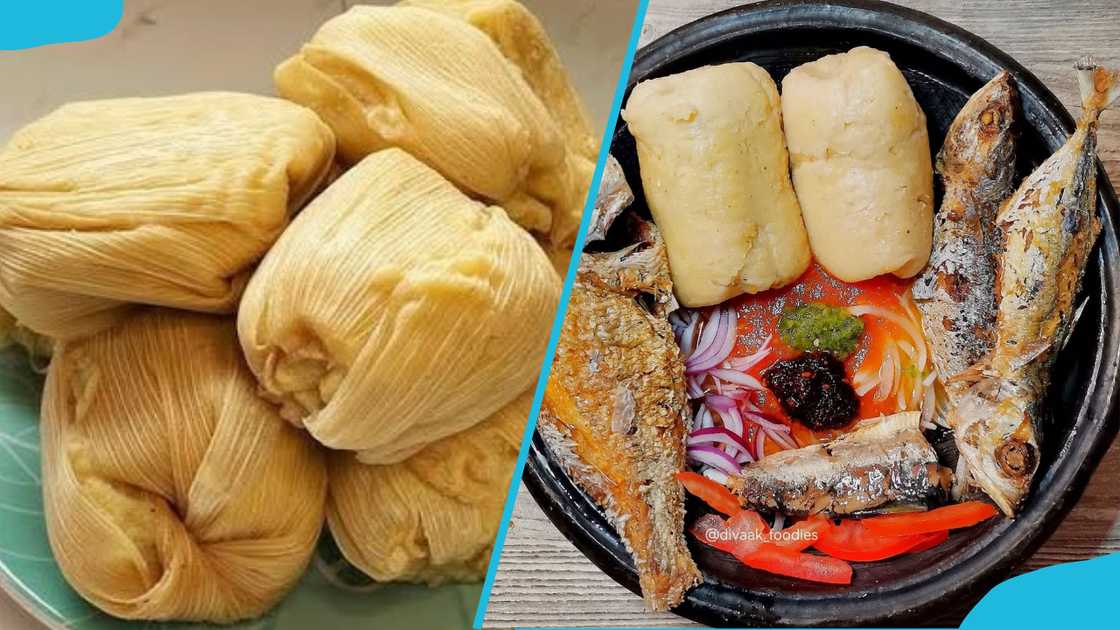Guan tribe: History, language, food, dance, festivals, facts
The Guan tribe, also known as Ghanjawiyyu, Gonja, Guang, or Ngbanya, is the largest ethnic group in Ghana. Descendants of the Gonja people were traders and the first residents of Ghana. Read below the history and cultural practices of the Guan tribe and interesting facts about this community.

Source: UGC
TABLE OF CONTENTS
- Guan tribe's history
- Where did the Guan ethnic group migrate from?
- Where did the Guans first settle in Ghana?
- Who defeated the Guans?
- Which region is Guan in Ghana?
- What ethnicity is Guan?
- What language do the Guans speak?
- What are the three languages of Guan?
- Guan food
- Guan festivals
- Guan dances
- Guan economic activities
- Guan religion
- Guan political leadership
- What dress do the Guans wear?
- Are Guans Akans?
- Facts about the Guan tribe
Guan people are one of the 26 or more Gonja ethnic groups. Gonja people mainly inhabit the northern region of Ghana, above the Black and White Volta rivers' confluence. Their original name was Ngbanye, which means Brave Men. The name Gonja was derived from the Hausa phrase Kada Goro-Jaa, meaning Land of Red Cola.
Guan tribe's history
Although they were the first settlers in Ghana, some Guans were assimilated into the cultures of other major ethnic groups that later settled in various parts of Ghana.
As a result, the Guans are very tolerant and live as commoners in various regions of Ghana. Below is a brief history of these people:
Where did the Guan ethnic group migrate from?
Guan people are believed to have migrated to Ghana around A.D. 1000 from the Mossi region of modern Burkina Faso. They were forced to leave Burkina Faso due to conflicts with the Mande of the Mali Empire.
Where did the Guans first settle in Ghana?
The Guan people first settled in the northern regions of Ghana along the Volta River, one of the country's largest rivers.
As time passed, they moved southwards through the Volta Valley and settled along Black Volta, throughout the Afram Plains in the Volta Gorge in the Akwapim Hills.
The ancient Guan state or kingdom was first established in northern Ghana between 1550 and 1575 by the Malinke cavalrymen, Songhai's emperor.
Initially, they were ruled by the Mande people, also known as the Malinke, Mandingo, Maninka, or Manding. Throughout the years, the Guan tribe was influenced by the Mande and other neighboring communities.
Who defeated the Guans?
Years after establishing their kingdom, they were conquered by the Akwamu, Dankyira, and Asante in the 17th century. In the 18th century, they, like their neighbors, were defeated by the expanding Asante Empire.

Source: UGC
When the British defeated Asante in 1901, the Gonja people, including the Guan, became part of the British Northern territories. Under the colonialists, the Gonja continued to be subsistence farmers and migrant workers.
Currently, the Guan people are found in twelve regions in Ghana: Oti, Northern, North East, Savannah, Bono, Ahafo, Central, Western North, Western, Eastern, Volta, and Brong Ahafo Regions.
Which region is Guan in Ghana?
The Guan District is in the Oti Region of Ghana, and its capital is Lipke-Mate. The district was created in 2019 from the Hohoe Municipality.
What ethnicity is Guan?
The Guans are of an African ethnic background, and most are natives of Ghana.
What language do the Guans speak?
These people speak a variety of Guan languages of the Niger-Congo language family. Guan languages in Ghana comprise:
- The northern Guans languages comprise the Anii, Chumburung–Tchumbuli, Dwang, Foodo, Gonja, Kplang, Krache, Nawuri, Nchumbulu, Nkonya–Nkami, Ntrapo, and Vagala.
- The southern Guans languages are Efutu-Awutu, Leteh, and Kyerepong.
Some of these Guan languages are influenced by major languages in Ghana, depending on where a particular Guan tribe is located:
- The Anum, Boso, Larteh, Okere, and Kyerepong in eastern Ghana.
- The Buem, Nkonya, Likpe,Amedzofe, and Vane in the Volta Region.
- The Efutu and Awutu living in the central Ghana, Senya, and Bawjiase areas.
- The Gonja people in Brong Ahafo, Bono, and Ahafo parts of Ghana.
- The Nawuri people are in the north and parts of the Oti Region.
What are the three languages of Guan?
The three most popular Guan languages are the Leteh, Kyerepong, and Efutu.
Guan food
Their traditional staple food is called Kenkey. It is prepared from de-husked and dried maize grains, which are soaked in water for three days, rinsed in freshwater, and ground into flour.

Source: UGC
The flour is kneaded into a dough. Half of the dough is cooked, while the rest remains uncooked. Then, the two doughs are mixed thoroughly.
The mixture is wrapped in maize husks and boiled for one to three hours until it is ready to serve. Kenkey has also provided employment and income for the local maize farmers, retailers, corn mill workers, and hotels.
As a favorite food among the Guans, it is popularly said that a Guan hasn't eaten if he does not eat Kenkey during the day.
Guan festivals
The Guans celebrate Ohum and Odwira festivals, combining artistic, recreational, ritual, and ceremonial activities. The ceremonies take place at selected locations and according to schedule.
Ohum and Odwira festivals provide opportunities for the collective renewal of arts as the people enjoy a lot of music and dancing as a community.
Odwira festival
The festival is celebrated in memory of the Great Akantamansu War of 1826, whereby the allied forces of Akuapem, Ga, Efutu, Awutu, and the British fought against the Ashantis.
Odwira festival is held mainly to purify the community of dirt and impurities. During this festival, participants give thanks to their gods and ancestors, offer sacrifices, and feed the ancestral spirits.
In addition, this event offers opportunities to solve family disputes, contract marriages, harvest crops, and launch mid-crop farming..
Ohum festival
The festival marks the beginning of harvesting new crops. The Akuapem natives, the Okre and Larteh people, celebrate it annually.
Guan dances
The Kpana or Kpanaliumni dance is the most famous Guan dance. It is performed when a hunter kills leopards, hartebeest, or buffalo. The dance is also performed during funerals. As the Kuntunkure beats the drums, the talisman dances while wearing a traditional talisman cap.

Source: UGC
Guan economic activities
The Guan people cultivate maize and various types of millet on large fields. Although the Nchumuru people and other Gonjas also farm, their main economic activities are hunting and fishing.
Their main commercial product is shea butter, which is still exported to the Coast. The shea butter is also sold in the local market, shaped like a sugar cone and wrapped in leaves.
Shea butter is very easy to make. The shea tree seeds are roasted, pounded, and boiled in large pots. The fat that swims on top is the liquid form of the product. Sesame seeds are also exported from the Guan tribe in smaller quantities.
Guan religion
The Gonja, specifically the Guans, take religion seriously. Muslims make up about 58% of the Gonja population, while traditional worshipers constitute around around 38%. The remaining are Christians.
Traditional Guan worshipers believe in a supreme being called the Ebore, ancestral spirits, and traditional powers.
Guan political leadership
The modern Guang chiefdom has various traditional rulers who are linguistically and culturally different.
Most of the Guan traditional leaders descend from the Mande invaders. Others are commoners who speak Tano languages, while the rest of the rulers are Muslims who speak Gbanyito.
The Guans live in villages of about 300 persons. The villages are divided into territorial divisions, each ruled by a chief from the male hierarchy of Jakpa.
The paramount chief is called the Yagbumwura and is appointed in rotation by the chiefs of the five eligible divisions.
What dress do the Guans wear?

Read also
Wesley Girls alumni mock rival schools as Prof Naana Jane becomes first female Vice President
Traditional Guan clothing often incorporates vibrant colors, patterns, and fabrics like Kente, Adinkra, and Batakari.

Source: UGC
The men wrap the fabrics over their shoulders, while the women wear two pieces—an ankle-length dress and a shawl or sleeveless dress with fitting bodices and short or long skirts. The dresses are usually worn with head ties and traditional ornaments.
Are Guans Akans?
The Guans are not the same as the Akan, but the Akan language evolved from the Guan language. The two ethnic tribes of Ghana amalgamated to form the Akuapem people, who are known to be peaceful, humble, and respectful.
Ghanaians call the Akuapems "Ofie," which means "Home," because when upset, they show respect and humility with a one-sentence apology:
I am very sorry, but you are a fool.
Facts about the Guan tribe
- Most do farming, while a few practice hunting and fishing.
- Kenkey is their staple food.
- Ohum and Odwira are their main traditional festivals.
- They live in villages that are divided into territorial divisions.
- Their territorial divisions are headed by chiefs.

Read also
More attacks recorded on state institutions on the Mahama administration's first day at work
The Guan tribe is the earliest inhabitants of present-day Ghana and has a fascinating history and culture. Their festivals and dances, religious practices, and farming are unique. The Guan tribe is also the most educated in Ghana, with well-established administrative systems and competent leaders.
Yen.com.gh shared an article about the Ga-adangbe tribe, also known as Ga-Dangme, GaDangme, Ga-Adampa, Ga-Adangme or Ga-Danmel. Their original homeland was Goshen, Egypt.
The Ga-adangbe tribe consists of the Ga-Mashie and Gaspeaker, who migrated from Akwapim, Anecho, in Togo. The tribe has exciting cultural aspects, including festivals, dances, and unique traditional clothing.
Source: YEN.com.gh

Chris Ndetei (Lifestyle writer) Christopher Ndetei is a writer who joined the Yen team in May 2021. He graduated from Machakos Technical College in 2009 with a Diploma in ICT and has over four years of experience in SEO writing. Christopher specialises in lifestyle and entertainment coverage, with a focus on biographies, life hacks, gaming, and guides. He has completed the AFP course on Digital Investigation Techniques (2023) and earned the Google News Initiative Certificate (2024). In recognition of his work, he was named Yen Writer of the Year in 2024. You can connect with him via email at chrisndetei@gmail.com.

Peris Walubengo (Lifestyle writer) Peris Walubengo has vast experience in search engine optimization through digital content generation, research, editing, and proofreading. She joined Yen.com.gh in April 2022 and has done several Google News Initiative Courses. You can email her at perisrodah254@gmail.com.






